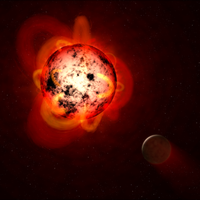Mini-Flares Potentially Jeopardize Habitability of Planets Circling Red Dwarf Stars
2017-06-06Cool dwarf stars are hot targets for exoplanet hunting right now. The discoveries of planets in the habitable zones of the TRAPPIST-1 and LHS 1140 systems, for example, suggest that Earth-sized worlds might circle billions of red dwarf stars, the most common type of star in our galaxy. But, like our own sun, many of these stars erupt with intense flares. Are red dwarfs really as friendly to life as they appear, or do these flares make the surfaces of any orbiting planets inhospitable?

Solar flares and associated eruptions can trigger auroras on Earth or, more ominously, damage satellites and power grids. Could flares on cool, red dwarf stars cause even more havoc to orbiting planets, even rendering them uninhabitable? To help answer that question, astronomers sought to find out how many flares such stars typically unleash.
A new study of archival ultraviolet observations from the Galaxy Evolution Explorer (GALEX) spacecraft detected dozens of flares from red dwarf stars. Some flares were weaker than any previously detected. Since smaller flares tend to occur more frequently, these tiny flares might have big implications for planetary habitability.
To address this question, a team of scientists has combed 10 years of ultraviolet observations by the Galaxy Evolution Explorer (GALEX) spacecraft looking for rapid increases in the brightnesses of stars due to flares. Flares emit radiation across a wide swath of wavelengths, with a significant fraction of their total energy released in the ultraviolet bands where GALEX observed. At the same time, the red dwarfs from which the flares arise are relatively dim in the ultraviolet. This contrast, combined with the time resolution of the GALEX detectors, allowed the team to measure events with less total energy than many previously detected flares. This is important because, although individually less energetic and therefore less hostile to life, smaller flares might be much more frequent and add up over time to produce an inhospitable environment.

 Search
Search

